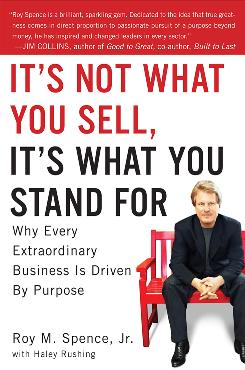That’s exactly what It’s Not What You Sell, It’s What You Stand For by Roy Spence Jr. does. It aims to motivate people to create or find work with a purpose that allows them to make money whether they’re an independent contractor, a small-business owner, a CEO of a billion-dollar enterprise or head of a non-profit organization. It’s about having a purpose in what you do. That, Spence argues, is the secret of extraordinary companies.
In these times, when much is written of financial implosions, layoffs, foreclosures and more, there’s something energizing about reading a book on how to succeed. It’s plain: Find your purpose and stick to it.
Spence has been a marketing guy for more than 35 years. He knows how to sell an idea. And sell he does. He makes you yearn for a purpose. As CEO of GSD&M Idea City, a national marketing and communications firm, Spence’s clients include Southwest Airlines, BMW, John Deere, Wal-Mart, the Clinton Global Initiative and AARP — all purpose-driven enterprises. “We help organizations identify and articulate the core purpose that’s right under their nose,” Spence writes.
The heart of the book revolves around ways to develop a purpose statement. And that comes down to lots of soul-searching mixed with sleuthing. He asks, “Why do you do what you do? Why is that important to the people you serve? Why does the existence of your organization matter?”
If you ask these questions, “Your purpose may very well jump out and start dancing around in front of you,” Spence writes.
Once you know your purpose and can articulate it with passion, then everything makes sense and everything flows, he eagerly promises. “You can feel good about what you are doing and clear about how to get there. You’re excited to get up in the morning, and you sleep easier at night.”
It begins with an understanding of the difference that you want to make in the world, Spence explains. Having clarity about the ultimate purpose of the time and energy you spend doing what you do is what drives you. Ask yourself: What are you deeply passionate about? What can you be the best in the world at? Ask your customers: What difference has your product/service made in their life? What would they lose if you ceased to exist? Sometimes you need to go back to why the company was founded in the first place and talk to retirees who were around in the early days.
Some purpose statements to use as a guideline:
•Charles Schwab: To be a relentless ally for the individual investor.
•BMW: To enable people to experience the joy of driving.
•AARP: To champion positive social change that will enhance the quality of life for all as we age.
Preaches Spence: “The simpler the statement is, the greater the understanding, adoption and, ultimately, alignment through the organization.” But it should also aim high. A properly crafted purpose should trumpet a “lofty and noble goal that’s worthy of your life’s work.” It should inspire people.
With a purpose in place, decision-making becomes easier. You can look at an opportunity or a challenge and ask yourself, “Is this the right thing to do given our purpose? Does this further our cause?”
If it does, you do it. If it doesn’t, you don’t, he advises. Purpose will steady you in a turbulent marketplace. “Markets are always changing. Competitors come and go. Trends rise and fall. So what’s going to be your anchor?” Spence asks.
This is an easy book to digest. At the end of each chapter, there’s a bold list of summary statements with the gist of the chapter summed up in simple sentences. There are interactive surveys that readers are urged to fill out to guide them through the process of developing a purpose statement and putting it to work.
He backs up his cheerleading spirit with 10 case study examples from his blockbuster client list. One caution: You can’t delegate the creation of purpose to middle management. While your purpose has to pervade every part of the company, “The leaders at the top need to unequivocally believe in the values,” Spence writes.
In other words, to paraphrase writer Ralph Waldo Emerson, it’s up to you to put your creed into your deeds.
It’s Not What You Sell, It’s What You Stand For: Why Every Extraordinary Business is Driven by Purpose by Roy M. Spence, Jr. with Haley Rushing; Portfolio, 318 pages, $25.95.





You must be logged in to post a comment.